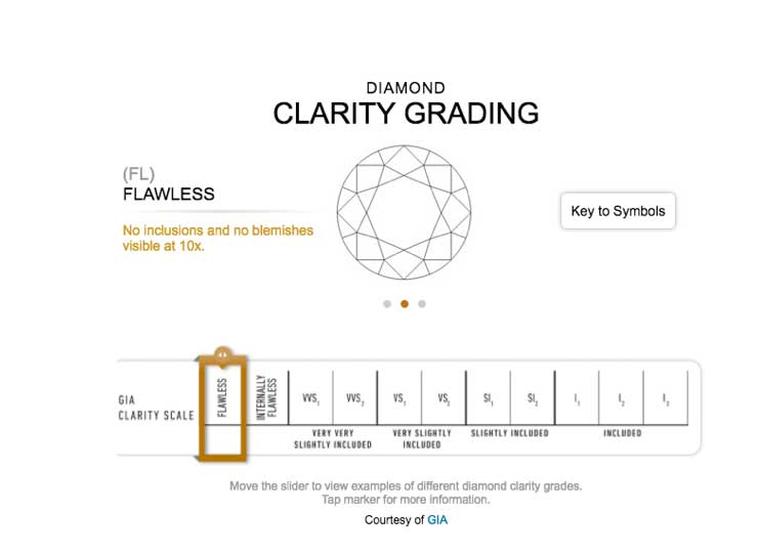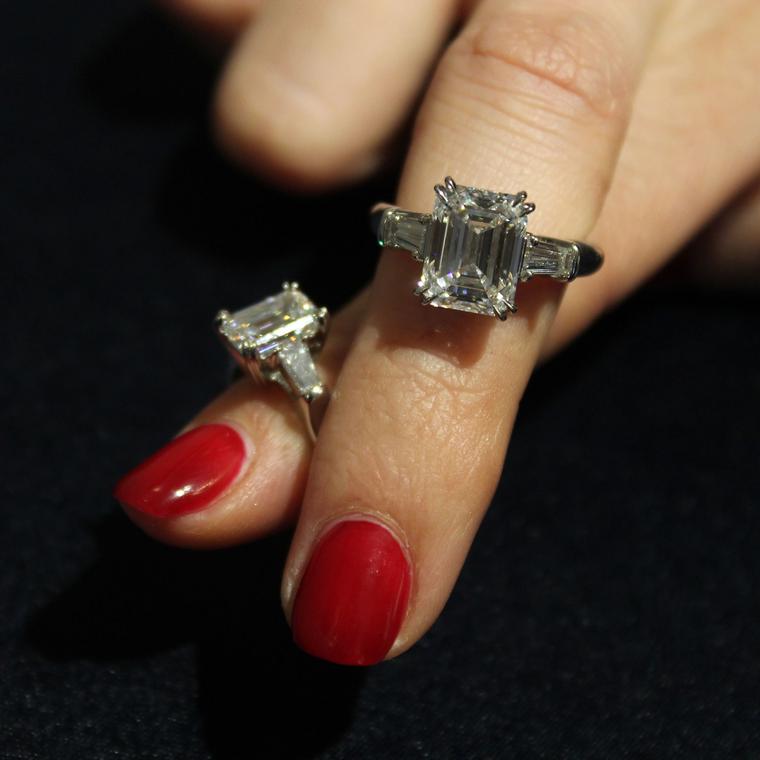
Navigating the famous 4Cs can be a daunting prospect when you’re shopping for a diamond engagement ring. All diamonds are graded on four factors – cut, clarity, colour and carat weight – which are used to determine their overall quality and, ultimately, their selling price.
The universal standard for judging the quality of a diamond was first introduced by the Gemological Institute of America (GIA) in the mid-20th century and this International Diamond Grading System is now used to assess diamonds from all over the world. Familiarising yourself with the 4Cs will make it easier to compare one diamond to another based both on their visual appearance and the grades on their certificates.
According to the GIA, a diamond’s clarity grade describes “the appearance and placement of characteristics both inside the diamond and on its surface”. Because diamonds were formed deep within the earth, where they were subject to intense heat and pressure, it is very rare to find a stone without any structural imperfections. When these unique birthmarks are located on the stone’s surface they are called blemishes, and if the flaws are on the inside they are known as inclusions.

The latter are always naturally formed and include air bubbles, cracks and non-diamond minerals found inside the diamond. Blemishes, on the other hand, are either natural or manmade and usually caused by the improper handling of the diamond or scratches and chips that can occur during the cutting process. These surface imperfections tend to be less of a concern as they can often be polished away and usually do not inhibit light from entering the diamond. While every effort will be made to disguise inclusions, these will remain inside the stone even if they are not visible to the naked eye.
The GIA clarity scale, above, measures the extent of these internal and external flaws, and knowing how the scale works can help you find the right diamond within your budget. It is important to remember that no two diamonds are exactly the same and almost every diamond has imperfections of some kind when viewed under the 10X magnification used during the grading process.
The GIA scale has six categories, broken down into 11 different grades that diamonds are placed into depending on the size, nature, position, colour and quantity of inclusions and blemishes. The highest clarity grades are Flawless (FL) and Internally Flawless (IF), which mean that an experienced diamond grader cannot see any inclusions or blemishes using a 10X powered loupe. The only difference between these two categories is that internally flawless gems have visible polishing lines on the surface, although the diamond itself is still completely free from inclusions. Perfectly colourless and internally flawless diamonds represent a tiny 0.001% of all diamonds mined worldwide, making them not only exceedingly rare but also eye-wateringly expensive.
The next categories are Very Very Slightly Included (VVS1 and VVS2) and Very Slightly Included (VS1 and VS2), which are each divided into two sub-categories to allow for even more accurate grading. Diamonds in all of these categories will appear flawless to the naked eye.
As we move further down the scale into the Slightly Included (SI1 and SI2) grade, the waters start to get a bit murkier and inclusions can affect the appearance of the diamond even without a microscope. At the same time, there are SI2 diamonds that are “eye clean” – in other words they appear to be the same as a VVS or VS diamond when viewed without magnification. However, Mehdi Saadian, director of the GIA School in London, points out that even without visible flaws, a lower clarity grade can have an impact on a diamond’s longevity. “Diamonds with lower clarity grades are considered less durable because their inclusions can sometimes worsen over time, which could affect durability and quality.”

Because most interior and exterior flaws cannot be captured on a photograph, the GIA uses a diamond plot to show the type and position of each flaw that affects a diamond’s clarity grade. The colour green is used to illustrate surface blemishes while red signifies internal inclusions. However, the plot is not an accurate representation of the visual appearance of a diamond. An SI1 or lower diamond might have a comparatively clean plot with only one or two flaws, but these may be so bad as to be visible without magnification.
The position of an inclusion also affects its visibility and diamond cutters always try to cut a stone so that the internal flaws cannot be seen through the table of the polished gem. Inclusions that are under the bezel facets or near the girdle are the hardest to see without magnification. Omar Vaja, Sales Director at Bentley & Skinner, says: “The worst location for an inclusion is to be under the table and near the pavilion, where the facets of the pavilion will reflect multiple images of it. A large feather near the girdle could shatter a diamond if hit hard enough.”
Julia Griffiths, who is a gemmology and diamond tutor at Gem-A, advises brides-to-be to steer clear of the lower range of clarity grades (I1, I2 and I3) and to exercise caution when shopping for diamonds in the SI2 range. “With the higher clarity grades, i.e. SI1 and above, there should be no visual difference without magnification and all of these stones will look flawless with the unaided eye, with regards to clarity.”
The question that inevitably follows is why would you buy a diamond of a higher clarity grade than SI1 if any flaws are invisible unless the diamond is viewed with a loupe? At this level it is more about value than visual appearance as diamonds with high clarity grades are much rarer and will therefore be worth more. Julia Griffiths also points out that each clarity grade covers a range so while some SI1 diamonds fall very near the VS2 classification, with no visible flaws, others may be nearer to a SI2 grading and have more noticeable inclusions. She adds: “For these reasons, unless the purchaser has experience with diamond grading, VS2 would be the lowest clarity grade grade I would recommend in a general sense for a good-quality diamond.”

If you’re shopping for an engagement ring on Bond Street you are unlikely to come across any diamonds with a clarity grade below VS2. Gemma Clark, sales associate and engagement ring expert at Boodles’ Bond Street flagship store, says: “When a diamond is graded at VS2 clarity or above, the inclusions do not affect the appearance of the stone. If the grade drops below this then you can potentially see the natural flaws, which may affect the appearance negatively. If there is an inclusion in the wrong place then it can be reflected several times, making the stone appear very flawed.”
This view is echoed by Jeremy Morris, Managing Director and Principal Designer of David Morris, who says: “We wouldn’t recommend going below VS2 clarity. You will then be purchasing a diamond that has no inclusions to the naked eye and, despite not being the best clarity, will still appear superior.” Around half of all diamonds purchased fall into the VS1-VS2 category, where you can get a visually flawless diamond for a fraction of what you would pay for a truly flawless gem.
Another point to bear in mind is that clarity should not be viewed in isolation when purchasing a diamond but needs to be considered alongside the other key factors that make up the 4Cs. In fact, Jeremy Morris believes that clarity should always be secondary to colour when selecting a diamond engagement ring. He says: “Of course it is important when buying diamonds, hence its inclusion in the 4Cs, but the beauty of a super white diamond is so wonderful that it outweighs a few inclusions.”
The cut of a diamond and its carat weight also come into play when you’re deliberating what clarity grade is the best for you. Some diamond cuts are more forgiving than others when it comes to clarity. The broad, flat facets of step cuts like the emerald and Asscher cuts will accentuate any imperfections in the diamond so any inclusions below VS2 are likely to be visible to the naked eye. A brilliant-cut diamond, on the other hand, can help disguise inclusions by breaking up the light as it is reflected from the many facets on the diamond’s surface. The size of the diamond also makes a difference as imperfections are easier to detect in larger stones. SI2 inclusions are often visible in diamonds over 1.00 carat and if you’re looking at a diamond over 2.00 carats, most jewellers would advise a clarity grade of at least VS2.

In the end, how far you are willing to compromise on clarity to get your dream engagement ring is a very personal decision. Each diamond is as unique as its owner and, while there is no substitute for comparing gems side by side, knowing how to tell your IF from your VVS and SI will help you make an informed choice within your budget.












